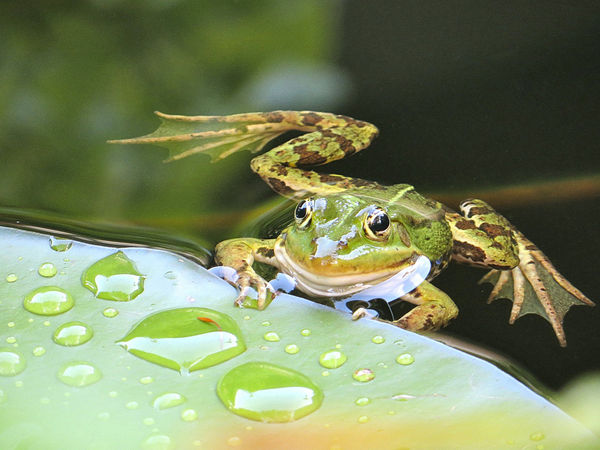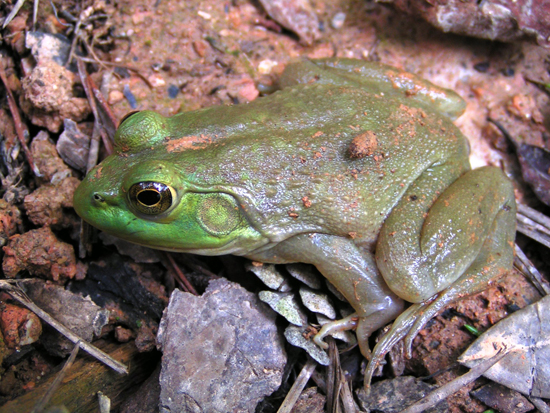Blotched Tiger Salamanders in Oregon
This report comes from Frances in Southern Oregon.
My two year old pond seems to have attracted these salamanders. I am in Southern Oregon, near Klamath Falls, and on the California border. I have been told they are Tiger Salamanders, but they do not have any bright coloring.
They are mottled and striped, and the largest one I have seen in my leaf trap was about 14″ long. The pond is about two and a half feet deep, so I can’t see how many there are, and if there are any of my goldfish left. Some of the fish were about 6 – 8 inches long when I last spotted them in late summer.
The salamander in the photo was on my driveway in early February of this year. I am pretty sure they are eating all the frogs we had. I am not hearing any croaking, and the two that frequented the rim of my hot tub are not around now. I am not sure if there is anything that can be done to balance things a bit, or if some of them are becoming permanent pond dwellers and not losing their gills, as I understand happens sometimes. Do you have any suggestions or ideas? Thank you. If these are some kind of hybrid, I don’t know how good they are for the environment.
*******
I sent this query along to a few experts and here are their responses:
Matt Ellerbeck – The Salamander Man says:
Your email/inquiry about salamanders was forwarded to me from Susan Newman at Frogs Are Green.
The salamander in the photo you sent is indeed a Tiger Salamander. They are variable in color, so if you Google searched them, it is possible that you came across images that didn’t resemble this individual salamander. Tiger Salamanders are native to Oregon so pose no environmental threat. On the contrary, salamanders are indicators of a healthy environment!
You also mentioned some concern for your frogs. Tiger Salamanders may occasionally take frogs, however, they primarily feed on insects and invertebrates. In fact, Tiger Salamander tadpoles (or larvae) prey on mosquito larvae and therefore help keep the number of these pests down! As such, I wouldn’t consider them a real threat to the frogs.
Due to the benefits they provide I hope you will accept the presence of these salamanders. If you want to learn about things you can to do help them (as they are both amphibians such efforts will also benefit frogs too) please visit the following: Save The Salamanders – How You Can Help
*******
I asked Matt why the frogs may have disappeared?
He replied:
Frances mentioned she didn’t hear the frogs croaking – perhaps the frogs are indeed still around but merely not singing at this time. I believe most frogs sing seasonally, or only at certain times. I have a backyard pond with frogs, and sometimes I may not see them for days on end, and suddenly they will reappear.
I have also read that cats will kill frogs, so they, or other predators (birds, snakes), may have taken them.
These are all plausible causes, however, I can’t say for certain. The reality is, any backyard pond (whether natural or human-man) that has animals in it will also attract various predators.
*******
Keith Gisser, Herpetologist and founder of Herps Alive! says:
Blotched Tiger Salamander. Pretty dull-colored animal normally compared to other (sub)species.
While pretty voracious eaters, rare (in my experience) for them to eat frogs or fish (although they will eat fish when in larval form) – they prefer invertebrates.
*******
Sara Viernum, Founder of The Wandering Herpetologist says:
Agreed! It’s a Blotched Tiger Salamander (Ambystoma mavortuim melanostictum). There is a small, known population (native) in southern Oregon near the border. Like all tiger salamander species these will eat anything that fits in their mouths including invertebrates, lizards, mice, snakes, frogs, tadpoles, small fish, and other salamanders. Since they are a native predator in your area they may initially cause a decrease in the local frog population but once they become established in your pond their numbers will most likely balance out with the frogs.
This site has some good info about the western tiger salamander group. California Herps – Salamanders

















